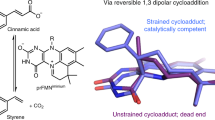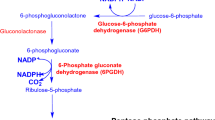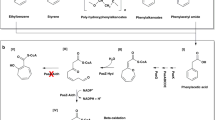Abstract
Pyruvate formate-lyase (PFL) from Escherichia coli uses a radical mechanism to reversibly cleave the C1-C2 bond of pyruvate using the Gly 734 radical and two cysteine residues (Cys 418, Cys 419). We have determined by X-ray crystallography the structures of PFL (non-radical form), its complex with the substrate analog oxamate, and the C418A,C419A double mutant. The atomic model (a dimer of 759-residue monomers) comprises a 10-stranded β/α barrel assembled in an antiparallel manner from two parallel five-stranded β-sheets; this architecture resembles that of ribonucleotide reductases. Gly 734 and Cys 419, positioned at the tips of opposing hairpin loops, meet in the apolar barrel center (Cα–Sγ = 3.7 Å). Oxamate fits into a compact pocket where C2 is juxtaposed with Cys 418Sγ (3.3 Å), which in turn is close to Cys 419Sγ (3.7 Å). Our model of the active site is suggestive of a snapshot of the catalytic cycle, when the pyruvate-carbonyl awaits attack by the Cys 418 thiyl radical. We propose a homolytic radical mechanismfor PFL that involves Cys 418 and Cys 419 both as thiyl radicals, with distinct chemical functions.
This is a preview of subscription content, access via your institution
Access options
Subscribe to this journal
Receive 12 print issues and online access
$189.00 per year
only $15.75 per issue
Buy this article
- Purchase on Springer Link
- Instant access to full article PDF
Prices may be subject to local taxes which are calculated during checkout








Similar content being viewed by others
References
Kessler, D. & Knappe, J. Anaerobic dissimilation of pyruvate. In Escherichia coli and Salmonella, cellular and molecular biology (eds Neidhardt, F.C. et al.) 199–205 (American Society for Microbiology, Washington, DC; 1996).
Knappe, J., Neugebauer, F.A., Blaschkowski, H. P. & Gänzler, M. Post-translational activation introduces a free radical into pyruvate formate-lyase. Proc. Natl. Acad. Sci. USA 81, 1332– 1335 (1984).
Wagner, A.F.V., Frey, M., Neugebauer, F.A., Schäfer, W. & Knappe, J. The free radical in pyruvate formate-lyase is located on glycine 734. Proc. Natl. Acad. Sci. USA 89, 996–1000 (1992).
Frey, M., Rothe, M., Wagner, A.F.V. & Knappe, J. Adenosylmethionine-dependent synthesis of the glycyl radical in pyruvate formate-lyase by abstraction of the glycine C-2 pro-S hydrogen atom. Studies of [2H]glycine-substituted enzyme and peptides homologous to the glycine 734 site. J. Biol. Chem. 269, 12432– 12437 (1994).
Külzer, R., Pils, T., Kappl, R., Hüttermann, J. & Knappe, J. Reconstitution and characterization of the polynuclear iron-sulfur cluster in pyruvate formate-lyase-activating enzyme. Molecular properties of the holoenzyme form. J. Biol. Chem. 273 , 4897–4903 (1998).
Knappe, J., Blaschkowski, H.P., Gröbner, P. & Schmitt, T. Pyruvate formate-lyase of Escherichia coli: the acetyl-enzyme intermediate. Eur. J. Biochem. 50, 253– 263 (1974).
Stubbe, J. & van der Donk, W.A. Protein radicals in enzyme catalysis. Chem. Rev. 98, 705–762 ( 1998).
Knappe, J., Elbert, S., Frey, M. & Wagner, A.F.V. Pyruvate formate-lyase mechanism involving the protein-based glycyl radical. Biochem. Soc. Trans. 21, 731–734 (1993).
Parast, C.V., Wong, K.K., Lewisch, S.A. & Kozarich, J.W. Hydrogen exchange of the glycyl radical of pyruvate formate-lyase is catalyzed by cysteine 419. Biochemistry 34, 2392– 2399 (1995).
Logan, D.T., Andersson, J., Sjöberg, B.-M. & Nordlund, P. A glycyl radical site in the crystal structure of a class III ribonucleotide reductase. Science 283, 1499– 1504 (1999).
Uhlin, U. & Eklund, H. Structure of ribonucleotide reductase protein R1. Nature 370, 533– 539 (1994).
Heβlinger, C., Fairhurst, S.A. & Sawers, G. Novel keto acid formate-lyase and propionate kinase enzymes are components of an anaerobic pathway in Escherichia coli that degrades L-threonine to propionate. Mol. Microbiol. 27, 477–492 (1998).
Reddy, S.C. et al. Dioxygen inactivation of pyruvate formate-lyase: EPR evidence for the formation of protein-based sulfinyl and peroxyl radicals. Biochemistry 37, 558–563 (1998).
Unkrig, V., Neugebauer, F.A. & Knappe, J. The free radical in pyruvate formate-lyase. Characterization by EPR spectroscopy and involvement in catalysis as studied with the substrate-analogue hypophosphite. Eur. J. Biochem. 184, 723 –728 (1989).
Himo, F. & Eriksson, L.A. Catalytic mechanism of pyruvate formate-lyase (PFL). A theoretical study. J. Am. Chem. Soc. 120, 11449–11455 (1998).
Engel, C. & Wierenga, R. The diverse world of coenzyme A binding proteins. Curr. Opin. Struct. Biol. 6, 790–797 (1996).
Plaga, W., Frank, R. & Knappe, J. Catalytic site mapping of pyruvate formate-lyase. Hypophosphite reaction on the acetyl-enzyme intermediate affords carbon-phosphorus bond synthesis (1-hydroxyethylphosphonate). Eur. J. Biochem. 178, 445–450 (1988).
Sawers, G. Biochemistry, physiology and molecular biology of glycyl radical enzymes. FEMS Microbiol. Rev. 22, 543– 551 (1999).
Rödel, W., Plaga, W., Frank, R. & Knappe, J. Primary structures of Escherichia coli pyruvate formate-lyase and pyruvate-formate-lyase-activating enzyme deduced from the DNA nucleotide sequences. Eur. J. Biochem. 177, 153–158 ( 1988).
Knappe, J. & Wagner, A.F.V. Glycyl free radical in pyruvate formate-lyase: synthesis, structure characteristics, and involvement in catalysis. Methods Enzymol. 258, 343– 362 (1995).
Kunkel, T.A. Rapid and efficient site-specific mutagenesis without phenotypic selection. Proc. Natl. Acad. Sci. USA 82, 488– 492 (1985).
Kabsch, W. Evaluation of single-crystal X-ray diffraction data from a position-sensitive detector. J. Appl. Crystallogr. 21, 916– 924 (1988).
Kabsch, W. Automatic processing of rotation diffraction data from crystals of initially unknown symmetry and cell constants. J. Appl. Crystallogr. 26, 795–800 (1993).
Jones, T.A., Zou, J.Y., Cowan, S.W. & Kjeldgaard, M. Improved methods for building protein models in electron density maps and the location of errors in these models. Acta Crystallogr. A 47, 110–119 (1991).
Brünger, A.T. et al. Crystallographic & NMR system (CNS): a new software system for macromolecular structure determination. Acta Crystallogr. D 54, 905–921 ( 1998).
Laskowski, R.A., MacArthur, M.W., Moss, D.S. & Thornton, J.M. PROCHECK: a program to check the stereochemical quality of protein structures. J. Appl. Crystallogr. 26, 283– 291 (1993).
Esnouf, R.M. An extensively modified version of MolScript that includes greatly enhanced coloring capabilities. J. Mol. Graphics 15, 132–134 (1997).
Kabsch, W. & Sander, C. Dictionary of protein secondary structure: pattern recognition of hydrogen-bonded and geometrical features. Biopolymers 22, 2577–2637 (1983).
Kraulis, P.J. MOLSCRIPT: a program to produce both detailed and schematic plots of protein structures. J. Appl. Crystallogr. 24, 946 –950 (1991).
Merritt, E.A. & Bacon, D.J. Raster3D: photorealistic molecular graphics. Methods Enzymol. 277, 505– 524 (1997).
Diederichs, K. & Karplus, P.A. Improved R-factors for diffraction data analysis in macromolecular crystallography. Nature Struct. Biol. 4, 269–275 (1997).
Acknowledgements
We thank D. Logan for providing class III ribonucleotide reductase coordinates preceding their general release, G. Sawers for the host E. coli strain RM221, D. Madden, K. Scheffzek and I. Schlichting for critical discussions and help, C. Lantwin and E. Pai for contributions in the early phase of the project, H. Wagner for maintenance of the X-ray facilities at the MPI Heidelberg, and K. Holmes for continuous support. Financial support of this work (by grants to J.K.) came from the Deutsche Forschungsgemeinschaft and the Fonds der Chemischen Industrie.
Author information
Authors and Affiliations
Corresponding authors
Rights and permissions
About this article
Cite this article
Becker, A., Fritz-Wolf, K., Kabsch, W. et al. Structure and mechanism of the glycyl radical enzyme pyruvate formate-lyase . Nat Struct Mol Biol 6, 969–975 (1999). https://doi.org/10.1038/13341
Received:
Accepted:
Issue Date:
DOI: https://doi.org/10.1038/13341
This article is cited by
-
Metabolic activity analyses demonstrate that Lokiarchaeon exhibits homoacetogenesis in sulfidic marine sediments
Nature Microbiology (2019)
-
Discovery of enzymes for toluene synthesis from anoxic microbial communities
Nature Chemical Biology (2018)
-
Transcriptome responses of Streptococcus mutans to peroxide stress: identification of novel antioxidant pathways regulated by Spx
Scientific Reports (2017)
-
Genome sequence of the filamentous soil fungus Chaetomium cochliodes reveals abundance of genes for heme enzymes from all peroxidase and catalase superfamilies
BMC Genomics (2016)
-
The catalytic mechanism for aerobic formation of methane by bacteria
Nature (2013)



